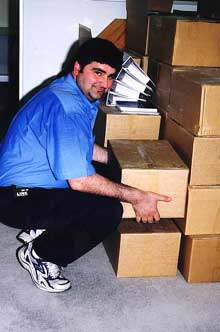
Provide a safe working environment
Occupational Health & Safety Legislation
Hazard Management Plans
As part of an effective risk management program, it is necessary to develop an implementation plan for conducting regular hazard identifications and assessment inspections.
During these inspections apart from the obvious structural or mechanical
hazards that you may identify, you should also be on the look out for unsafe
work practices.
Areas to consider are;
Manual handling
- Dealing with hazardous chemicals
- Storage and maintenance of equipment
- Emergency procedures

Manual Handling
Manual handling is a major occupational health and safety concern in a majority of retail stores. The National Standard for Manual Handling and National Code of Practice will assist you to implement effective manual handling programs in your workplace.Most daily activities contain some manual handling component. Activities that may lead to back injury are:
- lifting and lowering loads
- carrying,
stacking, pushing, pulling, rolling, sliding and wheeling loads
- operating
levers and other mechanical devices
- maintaining an unbalanced posture while performing these tasks.
 |
Risk factors that contribute to the possibility of manual handling injuries include:
|
If it's not possible to avoid these situations you need to consider if the workflow can be rearranged or modified to reduce the risk of injury.
 Injuries can occur if correct manual handling techniques and equipment are not used. |
Managing Manual Handling Hazards
To manage the manual handling functions in your store you should develop a clear policy based on relevant OHS information. From this policy the OHS committee will develop an information and/or training program.Your manual handling program should identify how you are going to achieve the objectives of the National Standard for Manual Handling and the National Code of Practice.
Generally, successful programs:
- involve consultation with employees
- are based on a risk identification process
- include commitment and training at all levels of the organisation
- involve practice by employees under a trainer's supervision
- involve continuous feedback from employees after implementation.
Establish Procedures for Manual Handling
A majority of workplace accidents occur due to poor manual handling procedures being employed by team members.An improvement in OHS standards could be achieved by implementing correct manual handling techniques.
 Manual handling procedure should include all workplace practices and equipment associated with the tasks. |
As previously stated, your store's OHS policies should be based on the relevant OHS legislation. By using the legislation as a guide and adopting the National Standard for Manual Handling you have a good platform to develop your store's manual handling policy and associated procedures.
The Manual Handling Training Program
Manual handling training is usually more effective when it's done in the person's work area rather than in a classroom. This allows you to demonstrate the skills, observe the participants' actions and guide them through the risk identification and assessment procedures in a realistic setting.|
The manual handling program strategy should include:
|
The primary objective should be to train the team in correct methods. This training should be undertaken when the hazard cannot be eliminated or reduced in any way.
 A manual handling training program should aim to identify, assess and control manual handling risks. |
The National Code of Practice specifies that manual handling training should include:
- an increased awareness and understanding of the manual handling activities
- hazard identification, workplace assessment and risk control by job and task design
- promotion and use of preferred manual handling techniques.
 A manual handling program should provide the team with the skills and knowledge they need to minimise workplace risk. |
|
Your manual handling training program should include the:
|
|
- training
should be based on the principles of safe manual handling not a particular
technique to lift
- the principles
must be adaptable to a variety of situations
- 'why' it is important, is just as critical as teaching 'how'